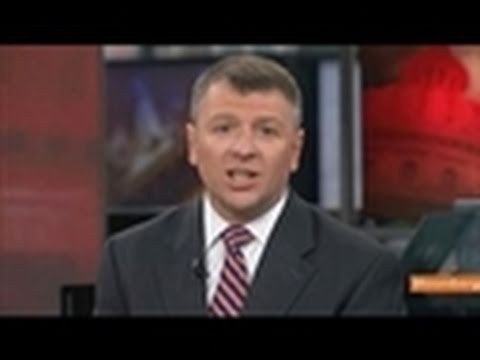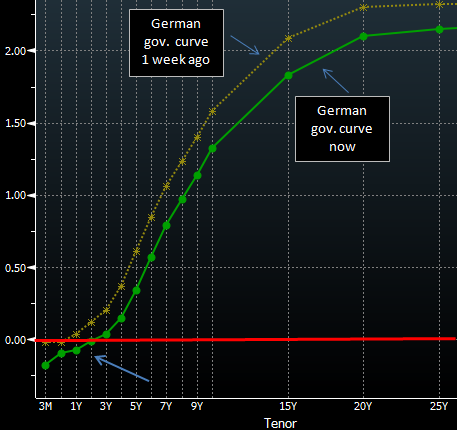Steepens as Bets Decline on Quicker Rate Boosts Bloomberg Business
Post on: 30 Апрель, 2015 No Comment

Aug. 4 (Bloomberg) — The difference between yields on Treasury five-year notes and 30-year bonds reached the widest in two weeks as investors cut bets on how quickly the Federal Reserve will raise interest rates.
The yield curve, as the gap is called, steepened last week for the first time in a month as the U.S. gained fewer jobs than forecast, pushing shorter-term rates down faster than longer-term yields. Traders saw a 45 percent chance the Fed will raise rates by June, versus 49 percent a month ago, fed funds futures trading showed. The Treasury said its borrowing needs this quarter fell to the lowest for the period since 2007.
“Until we get more data about the economy, we’ll be in a narrow range here,” said Ray Remy, head of fixed income in New York at Daiwa Capital Markets America Inc. one of 22 primary dealers that trade with the Fed. “We’ll consolidate around these levels.”
The five-year note yield fell two basis points, or 0.02 percentage point, to 1.65 percent at 5 p.m. in New York, according to Bloomberg Bond Trader data. The price of the 1.625 percent security due in July 2019 rose 2/32, or 63 cents per $1,000 face amount, to 99 29/32. Ten-year note yields fell one basis point to 2.48 percent, while 30-year bond yields were little changed at 3.29 percent.
The yield curve reached 164 basis points, the highest since July 18. It flattened significantly this year, reaching 149 basis points, the least since January 2009, on July 30 as Fed discussions of boosting interest rates next year hurt the appeal of shorter-term debt while uneven economic growth supported demand for longer-term securities. The curve reached a 2014 high of 223 basis points on Jan. 2.
Volume Slumps
The amount of Treasuries traded through ICAP Plc, the largest inter-dealer broker of U.S. government debt, dropped 61 percent to $197 billion, the least since July 23. The volume reached $504 billion on Aug. 1, the highest since May 2. The daily average this year is $327 billion.
A gauge of Treasury price swings ended last week at a four-month high after the U.S. economy expanded more than projected, the U.S. added fewer jobs than forecast and turmoil in Ukraine and the Mideast spurred safety demand.
Volatility jumped on Aug. 1 after the Labor Department reported U.S. nonfarm payrolls rose by 209,000 jobs in July, versus a Bloomberg survey’s forecast for a gain of 230,000. It was the sixth straight month employers added more than 200,000 workers. The data came after the government reported last week U.S. gross domestic product grew at an annualized 4 percent in the second quarter, more than forecast.
‘Moving Away’
The index measuring 10-day price swings rose to 3.8 on Aug. 1, a level not seen since March 25. Volatility had waned in 2014, with the index averaging 3.1, compared with 4.6 during the previous five years.
Morgan Stanley, a primary dealer, said it’s “moving away from the yield-curve flattening bias that we have held since June 18,” based on the reports on jobs and gross domestic product.
The five-year “looks particularly at risk if the Fed upgrades its assessment of the risks to the outlook,” Morgan Stanley strategists Matthew Hornbach and Steve Kang wrote in a note Aug. 1.
The curve is steepening as the Fed scales back its purchases of Treasuries, Bill Gross, manager of the world’s biggest bond fund at Pacific Investment Management Co. said in a post on Twitter.
The quantitative-easing program, in which the central bank buys bonds to hold down long-term borrowing costs, “was all five years-plus maturities,” he wrote. “Biggest buyer is disappearing.”
Fed Tapering
The Fed cut the monthly pace of bond-buying by $10 billion for a sixth time on July 30. That brought purchases to $25 billion, from $85 billion last year, on pace to end the program by October.
Policy makers also held the benchmark interest-rate target in a range of zero to 0.25 percent, saying slack persists in the labor market even as the economy is picking up.
The Treasury plans to borrow $192 billion from July through September, about $22 billion more than it projected three months ago, with an end-of-September cash balance of $150 billion, the department said today. Next quarter, it plans to borrow $187 billion, with $140 billion in cash Dec. 31. The budget deficit this fiscal year is the smallest since 2008.
The department will announce Aug. 6 the amounts it will sell in three- 10- and 30-year securities next week.

Risky Bet
Investors may be underestimating the pace at which the Fed will raise interest rates over the next two years, said Fed Bank of Richmond President Jeffrey Lacker.
Short-term interest-rate markets have for months priced in a slower tempo of increases than policy makers themselves forecast. That’s risky because the misalignment, a bet against a rate path that the central bank alone controls, could lead to volatility if traders have to adjust rapidly, Lacker said in an Aug. 1 interview at his office.
Ten-year yields dropped seven basis points on Aug. 1, the biggest decline in two weeks, after the employment report. That left the rate three basis points higher for the week.
The yields on the benchmark note will climb to 3.11 percent by Dec. 31, according to a Bloomberg survey of economists, with the most recent forecasts given the heaviest weightings.
Gross’s Pimco Total Return Fund had $830 million of net investor withdrawals in July, the smallest since redemptions began in May 2013, when clients began pulling money from the world’s biggest bond fund as performance faltered, according to Morningstar Inc.
The fund, run by Pacific Investment Management Co. in Newport Beach, California, has total assets of $223 billion, Chicago-based researcher Morningstar said in a statement. That’s down from $293 billion last year.
Investors started pulling money from the fund in May 2013 when the Fed first hinted it would unwind stimulus measures.
To contact the reporter on this story: Susanne Walker in New York at swalker33@bloomberg.net
To contact the editors responsible for this story: Dave Liedtka at dliedtka@bloomberg.net Greg Storey














